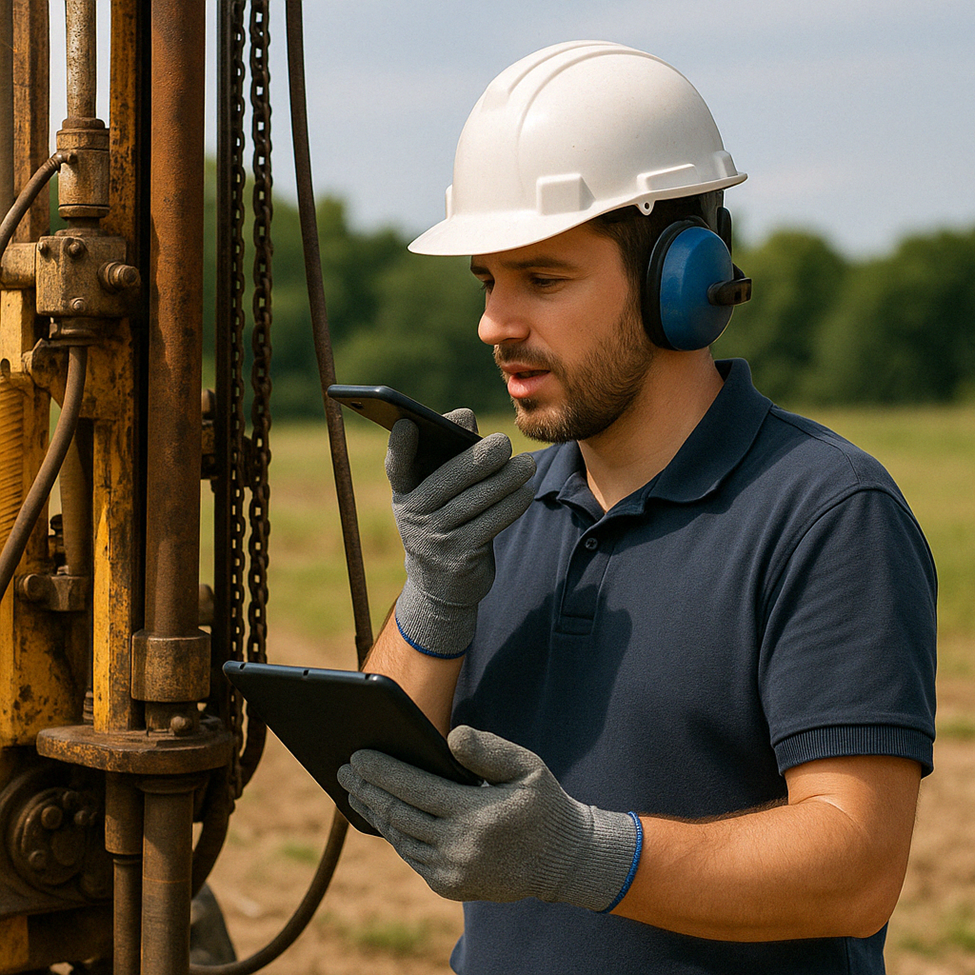How AI Voice Recognition Is Transforming Field Data Collection in CMT
April 24, 2025
Collecting field data is one of the most critical, but often most time-consuming tasks of construction materials testing (CMT). Whether it’s documenting boring logs, running a Proctor test, or capturing density readings, technicians are expected to record precise results quickly, often while managing heavy equipment, harsh environments, and strict timelines.
With the growing adoption of mobile solutions like eFieldData, the industry is already moving away from paper forms. But what’s next? One key innovation gaining traction is AI-powered voice recognition.
In this article, we explore how voice recognition enhances field data collection in CMT, where it fits in the workflow, and how it’s opening the door to safer, faster, and more inclusive testing environments.
The Reality of Field Work
Field technicians work in dynamic, often physically demanding job sites where gloves, dust, glare, or weather can interfere with data entry. Pausing to tap through digital forms isn’t always practical, especially when technicians are on the move or juggling multiple tests.
Here is where voice recognition can help bridge this gap.
Instead of typing, a technician can simply say:
“Sample ID 305. Moisture content 11.5. Dry density 119.7.”
The system captures the values and validates them on the spot, and the test results will be available in real-time with engineers in the office—no typing is required.
Practical Applications in Common Field Tests
Voice recognition is particularly suitable for high-volume, repetitive tests or forms that require quick review. Here are a few places where this feature shines:
Proctor Tests (Standard & Modified)
Technicians can dictate trial numbers, moisture contents, and density values without stopping to navigate dropdowns or keyboard inputs.
Example: “Trial 2, moisture 12.4 percent, dry density 116.8 pcf.”
Density Tests (Nuclear & Sand Cone)
Quickly record compaction readings, test outcomes, or location details. If values are outside acceptable thresholds, AI can prompt a confirmation.
Example: “Location 4B, density 123.5, compaction 94%.”
Boring Logs
Instead of typing out stratigraphy or observations, users can describe layers verbally:
Example: “Clayey silt with gravel from 0 to 6 feet, moist, firm. Sand layer begins at 6.5 feet.”
Photos can also be tagged with notes using simple commands, such as “Attach photo to sample 2, gravel transition.”
Concrete Tests
Entering values for slump, air content, and cylinder IDs by voice keeps technicians focused on the test itself.
Example: “Slump 3.5 inches. Air content 5.2%. Cylinder 3 labeled S-305.”
Multilingual Support: Speak in Spanish, Report in English
In many regions, field crews speak languages other than English, with Spanish being the most common. AI voice recognition can support multilingual entry, translating spoken phrases into standardized report language.
Example: “Contenido de humedad, once punto cinco” Automatically recorded as “Moisture content: 11.5%”
This enhances team productivity, improves communication, and reduces the need for language-based workarounds.
Summary of Key Benefits:
- Hands-Free Entry: Great for field crews wearing gloves or working around equipment
- Faster Workflows: Eliminate time spent tapping through forms
- Fewer Errors: AI catches outliers and confirms results in real time
- Multilingual Input: Helps bilingual teams contribute with ease
- Greater Safety: Less time looking at screens = more awareness on site
- Better Accessibility:Levels the playing field for newer or less tech-savvy technicians
Looking Ahead: Where Voice Meets Smart AI
Voice recognition itself isn’t new—speech-to-text tools have existed for years. However, the game changer in construction materials testing is voice-to-form translation, where spoken input is not only transcribed but also intelligently transformed into structured, standards-compliant test entries.
This next-generation voice recognition goes beyond dictation. It understands context, applies logic, and can even guide technicians through the form completion process using intelligent prompts and quality checks.
Here’s what the future may look like:
Voice-to-Form with Smart Autofill
The system intelligently places values into the correct fields based on form type, test flow, and past entries.
“Moisture 11.5, density 120.2, Proctor test— Trial 2.”
The system automatically fills in the correct section of the Proctor form with suggested pass/fail criteria.
Real-Time QA/QC Prompts
The system reviews voice-entered values against project specs or industry standards (e.g., ASTM, AASHTO) and flags discrepancies immediately.
“You said 15 pcf—confirm? That’s below the expected compaction threshold.”
Interactive Voice Guidance
The platform can ask intelligent follow-up questions to ensure complete, high-quality entries.
“Would you like to add a note for the failed trial?”
“Do you want to attach a photo to this boring log layer?”
Voice-Generated Reports
Technicians can dictate a summary, and the system generates a formatted report draft, ready for internal review or submission to the client.
“Tested four samples today. All passed. Moisture within range. Compaction average 95%.”
Final Thoughts
Voice recognition is more than a convenience; it’s a productivity tool for today’s field teams and a critical step toward smarter, more efficient CMT workflows.
For companies using eFieldData, this technology can elevate your operations by simplifying data entry, improving accuracy, and giving your technicians more freedom to focus on what matters: testing, observing, and delivering results.
Want to Be First to Try Voice-Enabled Field Forms?
eFieldData’s AI voice recognition features are currently in development and will be released soon. If you want to simplify field reporting, reduce manual entry, and save valuable time in the field, join our early access list.
